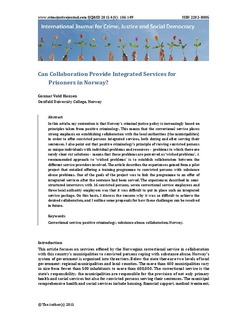Can collaboration provide integrated services for prisoners in Norway?
Journal article, Peer reviewed
Permanent lenke
http://hdl.handle.net/11250/2430098Utgivelsesdato
2015Metadata
Vis full innførselSamlinger
Originalversjon
International Journal for Crime, Justice and Social Democracy. 2015 4(4), 136-149Sammendrag
In this article, my contention is that Norway's criminal justice policy is increasingly based on principles taken from positive criminology. This means that the correctional service places strong emphasis on establishing collaboration with the local authorities (the municipalities) in order to offer convicted persons integrated services, both during and after serving their sentences. I also point out that positive criminology's principle of viewing convicted persons as unique individuals with individual problems and resources – problems to which there are rarely clear-cut solutions – means that these problems are perceived as 'wicked problems'. A recommended approach to 'wicked problems' is to establish collaboration between the different service providers involved. The article describes the experiences gained from a pilot project that entailed offering a training programme to convicted persons with substance abuse problems. One of the goals of the project was to link the programme to an offer of integrated services after the sentence had been served. The experiences described in semi-structured interviews with 16 convicted persons, seven correctional service employees and three local authority employees was that it was difficult to put in place such an integrated service package. On this basis, I discuss the reasons why it was so difficult to achieve the desired collaboration, and I outline some proposals for how these challenges can be resolved in future.
